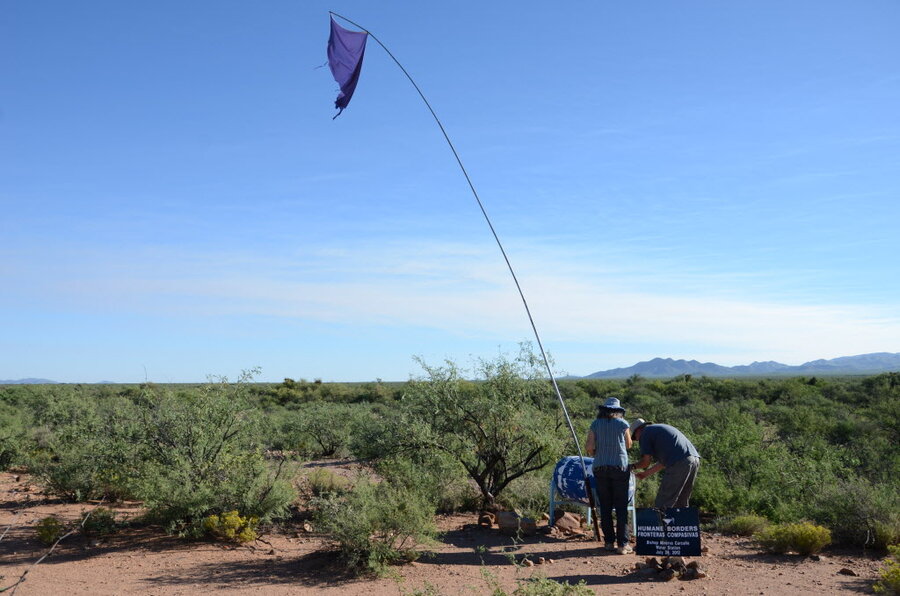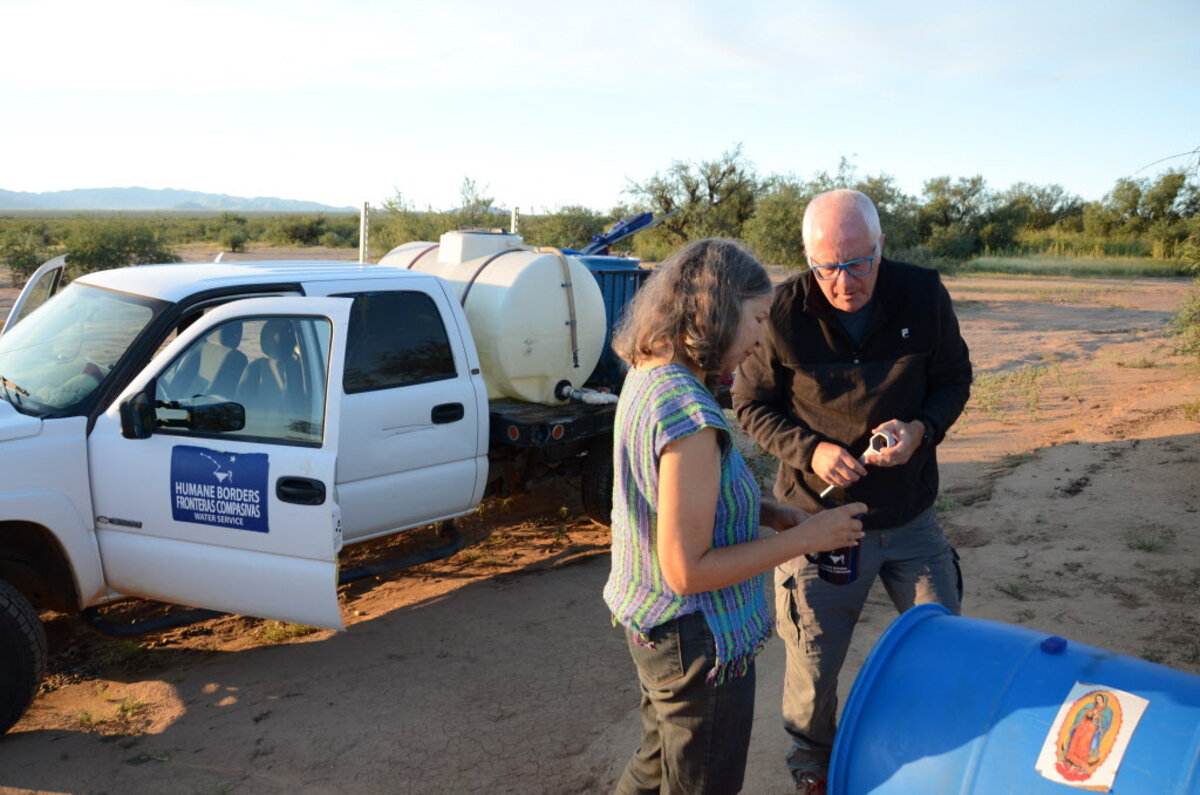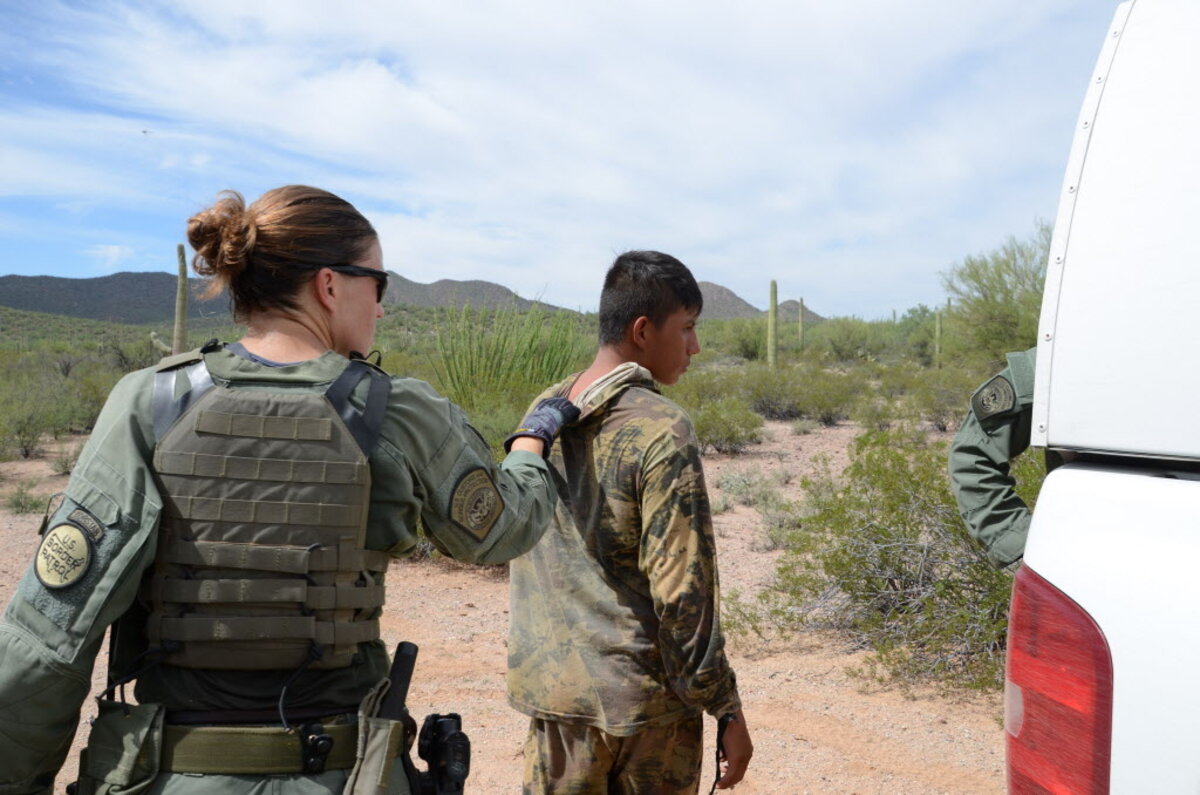A drop of water in the desert, and a flood of migrants
Loading...
Perhaps no issue divides Hillary Clinton and Donald Trump more sharply than what to do about illegal immigration. Part 5 of a five-part series on the view from the US-Mexico border.
SASABE, ARIZ. – There aren’t many Americans who can legitimately claim to have saved a human life. But that is the mission of Humane Borders.
The Tucson-based group maintains 48 emergency water supply stations in the Arizona desert where significant numbers of unauthorized migrants die every year of dehydration and exposure.
“We know the water is used,” says Stephen Saltonstall, a retired lawyer from Vermont and one of many volunteers who check the group’s water tanks once a week and refill them when needed.
Mr. Saltonstall is at the wheel of a well-worn truck carrying a large, sloshing water tank and several spare barrels. The rising sun paints the desert sky in brilliant slashes of orange and yellow as a coyote (the four-legged kind) trots across the road ahead and disappears into a stand of mesquite and cactus.
Why does he make these water runs?
“They are human beings,” he replies. “They deserve our compassion and our good will like any other human being.”
He adds: “I don’t understand why some people think that because you are an undocumented immigrant that means you deserve the death penalty in the desert.”
By some counts there are more than 25 different groups along the United States-Mexico border that regularly place water in the desert to help save the lives of dehydrated border crossers.
Not everyone agrees with their approach. Some ranchers in border areas refuse to allow groups to position fresh water on their land. They don’t want to encourage unauthorized migrants to come onto their property, and they don’t want to help anyone break US law.
Other critics say that the same supply of water prepositioned in the desert to sustain mothers and children fleeing violence in Central America can just as easily sustain would-be terrorists, drug smugglers, child sex traffickers, and assorted other dangerous criminals trying to sneak into the US. Humanitarian groups can’t guarantee who drinks their water.
“[These groups] are a big part of the problem,” says Tim Foley, who runs an organization called Arizona Border Recon. He believes Humane Borders and similar groups are enabling cross-border traffic that would otherwise be impossible.
“If you eliminated [the water stations,] you would probably cut what is coming across the border by almost 60 percent overnight,” he says. “They are facilitating it.”
The debate over desert water stations illustrates what some observers describe as an American approach to immigration that is at war with itself. In trying to embrace strict law enforcement principles of securing the border, while at the same time extending a compassionate and humanitarian hand to certain unauthorized immigrant families and individuals, the government has undermined its ability to succeed at either goal, they say.
The question of how to properly balance those objectives has divided the country and exposed sharp differences between the two presidential candidates.
Democratic nominee Hillary Clinton embraces the policies of President Obama – and would take them further. She has pledged to use additional executive actions to grant special legal status to millions of unauthorized immigrants living in the US. Mrs. Clinton also supports the president’s focus on targeting unauthorized immigrants who are criminals for deportation.
In contrast, her Republican challenger, Donald Trump, has embraced a hard-line approach. Anyone who entered the US without lawful authority must go home and get in line for a visa like everyone else. Mr. Trump also advocates strict enforcement of border security, a stance he illustrates by promising to build a 1,000-mile wall along the 1,954-mile US-Mexico border.
Amid the harsh political rhetoric of the current campaign season, volunteers at the border on both sides of the issue are doing their part to advance their highest concept of what America’s immigration policy should be.
Armed civilian patrols
Like Trump, Mr. Foley supports strict border enforcement.
He lives in the Arizona border town of Sasabe, and has spent years walking the smugglers’ trails and studying their tactics.
He says the Mexican cartels place spotters on ridges overlooking the valleys where drug mules and coyote-led migrant groups will cross into the US.
Foley’s organization – mainly retired law enforcement and ex-military personnel – conducts armed civilian patrols in remote regions near the border. They notify the Border Patrol of their location, and contact the agency when they encounter unauthorized migrants or drug traffickers.
Foley targets the most active trails. “We will go out and sit in certain areas for seven days at a time,” he says. “In November, I have a one-week op with 26 confirmed so far,” he says. “With 26 people I can probably close about 15 miles of border.”
When the smugglers start running into his group, they retreat to the border and wait or they try to go around, he says.
“We push them out of their most favorable terrain into the least favorable terrain for them – where it is really easy to get caught,” he says. “If they try to wait us out, you can only carry so much food and water. By sitting there we make them burn up their logistics.”
He adds: “Last time out we sat in this one area for seven days, and three days into it we had a dope mule walk across.” The man, one of several mules in a smuggling group, surrendered to Foley’s group, which turned him over to the Border Patrol.
The mule’s surrender illustrates how potentially that smuggling group’s operation was threatened by the scarcity of water and food.
Rather than risk the long trek back through the Mexican desert without adequate supplies, the man was forced to drop his drug load and cross the border into the US. There, he knew, he would receive food and water from the Border Patrol before being sent back to Mexico. In effect, it was his safest and fastest way home.
It also allowed him to leave his own water and food behind for his associates to help them continue to wait-out Foley’s group and eventually try to complete their drug smuggling operation. But Foley’s group was waiting, too.
“In that seven days, we had three dope mules walk across the border and turn themselves in to us,” Foley says.
Logistics – including water – are critical for smugglers, Foley says, whether it is drugs or people they are bringing over the border.
One gallon of water weighs 8.3 pounds. Many border crossers are carrying two gallons at the start of their trip. That might sustain an adult male for eight hours walking through the hottest part of the day, experts say – but is hardly enough to reach their destination.
Drug mules are already carrying a 50- to 60-pound bale of marijuana on their backs.
Foley says it is impossible to carry enough water to make the four-day trek through the Arizona desert to a secure pickup spot. He knows many border crossers end up dead.
“We’ve probably saved in the past six years close to 100 people,” Foley says. “Regardless of what I think or who I think you are, I’m not going to watch you die out there in the desert.”
But saving someone from death is different than effectively encouraging them to cross the US border illegally, he says. That’s what he believes Humane Borders and similar groups are doing.
“That is absurd,” says Dinah Bear, a Humane Borders volunteer on the water run with Mr. Saltonstall.
“I can’t believe that anyone would think that a person would wake up in the morning hundreds or thousands of miles away and leave their family and their community and walk in great danger and in great misery because they might get a free drink of water.”
Beacons of hope in the desert
Saltonstall turns the water truck off Route 286 and follows a dirt road through the arid landscape. He stops beside a blue 55-gallon barrel positioned under a blue flag on a 30-foot pole. It is designed to be seen from a distance. The barrel is fitted with a spigot that allows anyone who is thirsty to drink or fill a water container.
When Saltonstall and Ms. Bear reach their third water station of the morning, they sense something isn’t right. The water is low in the barrel. They both take turns smelling the contents of the barrel.
“I think it might be gasoline,” Saltonstall says.
Bear takes another whiff. Something is wrong, she agrees. “In the 26 years we’ve been doing this, we’ve only had this problem one other time,” she says.
The other time happened at this same water station, she adds.
Taking no chances, they empty the barrel and replace it with a clean barrel and fill it with fresh water.
“It is very hard for me to understand the mindset of these people [who would sabotage a water barrel],” Saltonstall says. “Either they are clueless, or they are trying to kill people.”
Bear says it is not uncommon to encounter some form of vandalism at various water stations; in prior instances, barrels were shot or slashed with a knife. “These stations are close to some residences,” she says. “So there is more traffic and people who don’t agree with our mission.”
When asked about such vandalism, Foley says it is probably just a hunter or an angry Border Patrol agent who opens up the spigot to let the water run out.
The Border Patrol has ordered its agents to stay away from water stations to allow them to serve their humanitarian purpose. Humane Borders advises its members to photograph and report the license plate number of any Border Patrol trucks seen in the vicinity of a water station.
Nonetheless, some migrant guides and smugglers are said to avoid the water stations because they believe they are a Border Patrol trap.
In addition to endorsing the placement of water stations in the desert, the Border Patrol has positioned emergency beacons in particularly lethal areas. The towers are 30-feet-tall with a solar-powered blinking blue light at the top visible for 10 miles. At the base of the tower is a red button with written instructions and a diagram for those who can’t read.
“If you need help push the red button. Rescue personnel will arrive shortly. Do not leave this area.”
The diagram shows a man with a backpack pushing the button and then sitting next to the tower. The final panel shows someone arriving with a gallon jug of water for the man.
There are 32 of these towers in the Border Patrol’s Tucson sector alone. During the past year, they transmitted an emergency message 375 times, according to the Border Patrol. During the same period, the Border Patrol rescued 1,409 individuals in the service's Tucson sector.
Smugglers lie to migrants
John Ladd runs a 16,000-acre cattle ranch near Naco, Ariz. It extends for 10 miles along the US-Mexico border. He’s seen his share of smugglers and undocumented migrants.
Years ago, they would offer the migrants food and water at the ranch house. But then word got out and too many people started showing up, he says.
For a while he had trouble with migrants breaking the waterline attached to a cattle trough on the south side of the ranch. “We were losing 10,000 gallons a day because of broken water lines,” he says.
The trough was less than a quarter-mile from the border.
Over the past 30 years, he says, 14 unauthorized migrants have died on his ranch. The most recent was last year, when a man drowned in a flash flood.
He says part of the problem is that many the migrants are illiterate and the coyotes leading them are lying about basic geography.
It is an observation nearly everyone repeats, from the Border Patrol to ranchers to migrant rights activists.
Ladd says the coyotes tell their clients that as soon as they cross the border they will see the lights of Phoenix. In reality, he says, they are the lights of Sierra Vista, roughly 30 miles from his ranch. Phoenix is 220 miles away.
“So these people are unprepared,” he says. “That’s part of the crime that America doesn’t realize, what [the human smugglers] are doing to them.”
Still, Ladd says he is opposed to the idea of leaving water out for people who are violating US immigration laws. He says the cross-border journey is dangerous, and that those who undertake it must assume the risks.
“You better know what you are doing,” he says, “and I’m not helping you do it.”
2,000 stickers with emergency info
Migrant deaths aren’t just a problem in Arizona. There are humanitarian groups leaving water all along the border with Mexico. But after Arizona, probably the second most lethal territory for unauthorized migrants is the hot and dry region north of Texas’ Rio Grande Valley.
In an attempt to cut down on deaths, the Border Patrol in Laredo has distributed some 2,000 stickers with an emergency telephone number and a set of GPS coordinates, which are displayed on deer stands common to ranches in that region.
On Oct. 5, a group of unauthorized migrants used a deer-stand sticker to contact the Border Patrol after they were abandoned by their coyote and became lost without food or water. The group was quickly rescued.
Ninety miles east of Laredo near Falfurrias, Texas, Eduardo Canales, director of the South Texas Human Rights Center, has established a network of humanitarian water stations on private ranchland near a major Border Patrol checkpoint on Route 281.
The checkpoint is more than 50 miles north of the border at the Rio Grande, but it is strategically located to intercept most vehicle traffic traveling north from the Rio Grande Valley toward Houston and San Antonio.
While women and children from Central America are routinely turning themselves in to the Border Patrol after crossing the river, tens of thousands of other unauthorized migrants, including anyone with a criminal background, are continuing to be smuggled into the US the old fashioned way. They hide in the underbrush, elude the Border Patrol, and make their way to stash houses north of the river. After a few days they are driven north where they must find a way to bypass the highway checkpoint.
Most smugglers require the migrants to walk as much as 30 miles around the checkpoint on a route that takes them through private ranchland. A coyote leads the way.
The area is hot and dry and thickly overgrown with mesquite and live oak. It is a hunter’s paradise, teeming with deer, wild turkey, and feral hogs.
This portion of the journey has proved to be particularly deadly. Mr. Canales estimates the death toll may rise to 60 this year.
“People are dying needlessly,” he says. “One death is too many.”
Like Humane Borders in Arizona, Canales recognizes that a well-placed bottle of water might save a life. He has permission from some of the ranchers to position water stations on their property. The stations are blue 55-gallon barrels in which Canales puts individual one-gallon water jugs. The spot is marked by a white flag with a red cross on a 30-foot pole.
He says he makes a water run at least once a week, and more often if necessary. On this day’s run in mid-September, 17 one gallon-jugs had been taken from 10 different water stations.
Also like Humane Borders, Canales says he is facing significant vandalism. He says recently 15 new water stations were destroyed, apparently by people who object to the idea of providing water for thirsty migrants.
It is disappointing, he says. But his job has its rewards. At one point Canales found a small slip of paper at the bottom of the blue barrel where a gallon jug of water had once sat.
The handwritten note is in Spanish. It reads: “Hello, May God protect you. I am going to pray for you.”
Part 1: Trump’s wall on the border: Will it work?
Part 2: The hopes and lies driving children to the US
Part 3: Alejandra, age 7, is facing a judge alone. Is that due process?
Part 4: Nature’s wall: the human toll of crossing the US border
Part 5: A drop of water in the desert, and a flood of migrants









